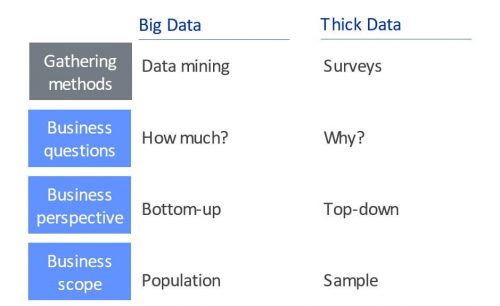For businesses to form a complete picture, they need both Big Data (quantitative information) and Thick Data (qualitative information). Each of them produces different types of insights at varying scales and depths. They may yield interesting synergies and complement each other.

In particular, the tactical decision-making level has a large decision-making gap that can leverage this ‘dual’ approach. On the one hand, analytics-based methods are able to quantify and generalize insights (Big Data); on the other hand, there are empirical approaches that can improve the business perspective and the depth of analysis (Thick data).
We’ve devised four main methods to integrate Thick into Big Data:
A great example of a blend of Big & Thick Data is a program launched by a leading Telco provider, with the goal of empowering staff to interact with customers on a personalized level.
The first approach was to combine 79k data variables around customer service and marketing into a single Net Promotor Score (NPS).
This model helped move from around 30k NPS attributions per year to scoring the whole customer base with an accuracy of around 80%.
The next step was a sentiment analysis over call center records to move into contextual customer insights, thus refining the NPS score.
Leverage NPS data allowed to differentiate marketing strategy and interaction guidelines between customer groups (detractor vs. passives vs. advocates). For example, to make carefully crafted outbound calls for detractors and use electronic direct marketing (EDM) for advocates. The insights obtained were also essential to ensure there was a clear follow-up point to use with each customer.
To engage staff was built a simple internal portal, with NPS, interaction scripts and key client info. At this point was critical to create strong engagement links with IT.
During the first six months, 50k customer issues were identified and solved. As a result, the customer perception (NPS scores) improved.
As we can learn from the previous case study, transformational projects involve cross-functional skills in Thick Data, Data Science and Management.
Effective transformational projects that leverage Big and Thick Data require: